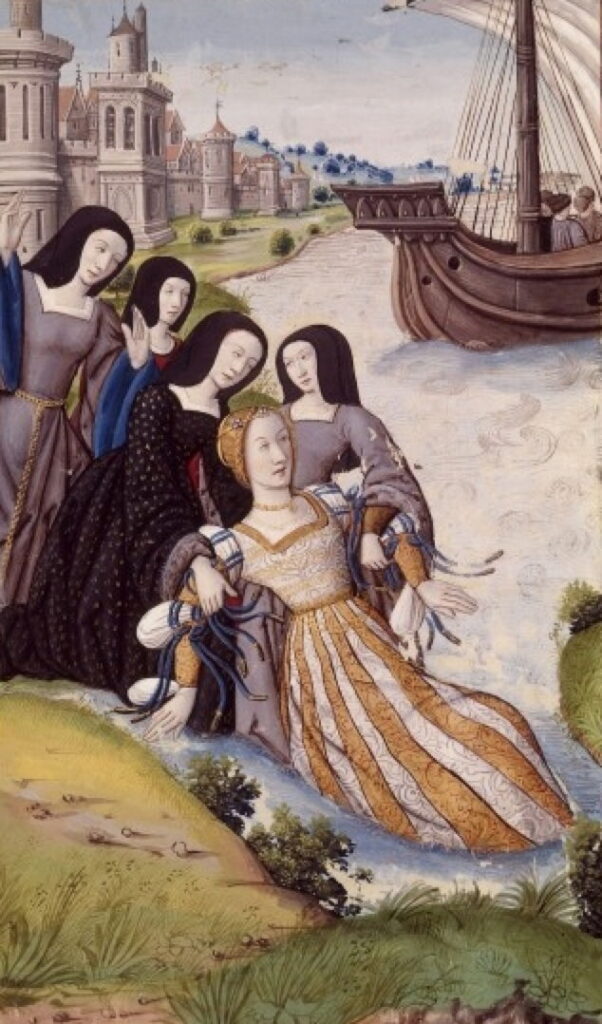Heroines: 2 Abandonment, suicide and scandal

In 1870, before he was made First Baronet of Rottingdean and of the Grange in 1894, Edward Coley Burne-Jones became the focus of a scandal when he was ‘invited’ to remove one of his paintings from an exhibition of the Old Water-Colour Society in London. The painting in question was one of only three significant depictions of the story of Phyllis and Demophoön, subjects of the second in Ovid’s collection of letters from Heroines.
Edward Burne-Jones (1833–1898), Phyllis and Demophoön (1870), bodycolour and watercolour with gold medium and gum arabic on composite layers of paper on canvas, 47.5 x 93.8 cm, Birmingham Museum and Art Gallery, Birmingham, England. Wikimedia Commons.
Burne-Jones’s offending Phyllis and Demophoön (1870) is a watercolour showing Phyllis embracing her estranged husband from within the structure of an almond tree. Exposure of Demophoön’s genitals in the exact centre of the painting was the most obvious reason for its removal, but behind it was a problem more compelling: both figures were modelled by Maria Zambaco, who had recently been Burne-Jones’ mistress.
Maria Zambaco was one of three cousins from the leading expatriate (if not refugee) Greek families of London; the other two were Aglaia Coronio and Marie Spartali, who later married to become known as the last Pre-Raphaelite painter, Marie Spartali Stillman (1844–1927).
Edward Burne-Jones (1833–1898), The Mill (1882), oil on canvas, 91 × 197 cm, The Victoria & Albert Museum, London. Wikimedia Commons.
All three appear in Burne-Jones’ The Mill (1882). Shown from left to right are Maria Zambaco, Marie Spartali Stillman, and Aglaia Coronio.
Burne-Jones had married Georgiana MacDonald in 1860, and the couple had a son the following year, and a daughter born in 1866. Maria Cassavetti was ten years younger than Burne-Jones, had married a Dr Zambaco in 1860, and went to live in France, having her own son and daughter by him. When her marriage collapsed in 1866, she moved back to London and met Burne-Jones when he was commissioned to paint her by her mother.
Burne-Jones and Maria Zambaco soon became lovers, a relationship that intensified during 1868, and reached a crisis the following year. Burne-Jones tried to leave his wife and family to live with Zambaco. Maria tried to convince Burne-Jones to join her in a suicide pact, taking an overdose of laudanum by the canal in London’s Little Venice. The police had to be called, and what was already quite a public scandal become the talk of London.
Although Burne-Jones and Zambaco broke up, he continued to use her as a model in his paintings through the 1870s, and in the group often known as the Three Graces in The Mill.
After the Old Water-Colour Society had ‘invited’ him to remove his Phyllis and Demophoön, Burne-Jones exhibited little for almost a decade. By 1880, though, he was ready to have another go at the same motif, using the same model.
Edward Burne-Jones (1833–1898), The Tree of Forgiveness (1881-82), oil on canvas, 190.5 × 106.7 cm, Lady Lever Art Gallery, National Museums Liverpool, Liverpool, England. Wikimedia Commons.
The Tree of Forgiveness (1881-82) was painted in oils, rather than watercolours, and its ambiguous title may refer either to the subject, or act as an invitation for the public to forgive the artist for his earlier behaviour.
Like Penelope’s Odysseus, Demophoön was another of the Greeks who took part in the Trojan War, and was the son of the better-known Theseus. Following the sack of Troy, he left the scene and sailed back towards Greece. Possibly as the result of a problem with his ship, he landed in Thrace, at the northern end of the Aegean Sea and to the north of Troy. There, he met Phyllis, the daughter of the local king, who fell in love with him.
Robinet Testard (fl 1470-1531), Plate of Phyllis Abandoned by Demophoon, Folio 15v in Octavien de Saint-Gelais (trans), Ovide, Héroïdes ou Epîtres (c 1520), Bibliothèque nationale de France, Paris. Wikimedia Commons.
Phyllis and Demophoön married, or perhaps their marriage was only agreed, but Demophoön had to travel back home before he could rejoin her later. He swore repeatedly that he would return, and Phyllis accompanied him as far as a place called The Nine Roads, where she gave him a casket, with strict instructions not to open it until he had abandoned all hope of returning to her.
Robinet Testard (fl 1470-1531), Plate of Phyllis Writing, Folio 11v in Octavien de Saint-Gelais (trans), Ovide, Héroïdes ou Epîtres (c 1520), Bibliothèque nationale de France, Paris. Wikimedia Commons.
Demophoön travelled on to Cyprus, where he may have settled, or he may have returned to Athens, and when the time came for his return to Phyllis, there was no sign of him. Phyllis wrote to him, in Ovid’s fiction the letter included in his Heroines, recording her despair after abandonment, and her determination to commit suicide.
Robinet Testard (fl 1470-1531), Plate of The Suicide of Phyllis, Folio 17 in Octavien de Saint-Gelais (trans), Ovide, Héroïdes ou Epîtres (c 1520), Bibliothèque nationale de France, Paris. Wikimedia Commons.
She apparently died by hanging herself in a grove of almond trees. This miniature shows her body becoming part of the tree, but those trees then became barren.
There are two recorded endings to this story. In one, Demophoön returned and was distraught to hear of her fate. When he visited the tree, he embraced it and sought her forgiveness. Then, as in Burne-Jones’ paintings, she transformed from the tree back to human form, and embraced Demophoön. The other version tells that, realising that he would never return to Phyllis, Demophoön opened the casket she had given him. Its contents then either drove him mad, or caused him to fall from his bolting horse, and die by his own sword.
The story of Phyllis and Demophoön was retold by Boccaccio in about 1343, by Chaucer in The Legende of Goode Women (1385), and in many operas from 1699 to 1811. As far as I can establish, there have only been three significant paintings made of the story: the two by Burne-Jones above, and the third may have been lost.
John William Waterhouse (copy?) (1849–1917), Phyllis and Demophoön (?1905), oil on canvas, 136.5 x 91.5 cm, Private collection. Wikimedia Commons.
John William Waterhouse’s Phyllis and Demophoön, thought to have been painted in 1897, had been presumed lost. A copy, perhaps made in about 1907, came to light when it was sold by Christie’s in London in 1926, but it too disappeared. More recently, the painting above was exhibited when in private ownership. Whether it’s thought to be the original or the later copy isn’t clear.
We may forgive Edward Burne-Jones, but hopefully we’ll never forget him, his model, or Phyllis and Demophoön.



